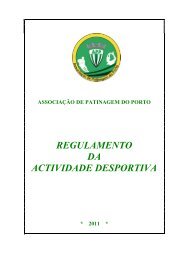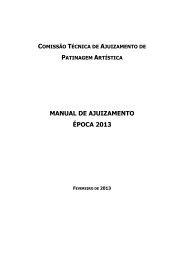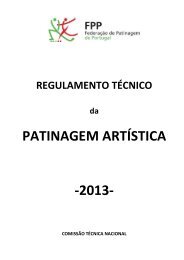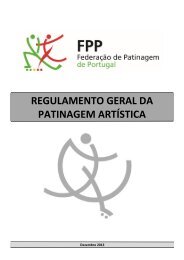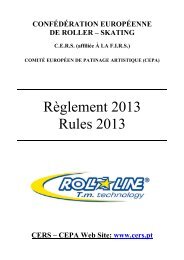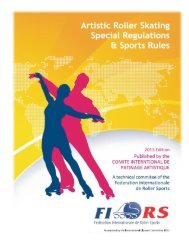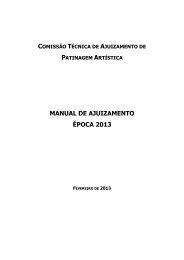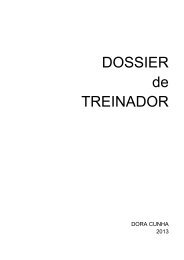You also want an ePaper? Increase the reach of your titles
YUMPU automatically turns print PDFs into web optimized ePapers that Google loves.
FS 5.08<br />
Starts<br />
5.08.01 Starts shall be made with a single push from a stationary position, without lunging, buckling, or<br />
double leaning.<br />
5.08.02 The thrusting or pushing foot shall be placed no more than one (1) skate length from the long axis.<br />
The start shall be made from the to-be-employed skate. Starts made from the toe stop shall be<br />
penalized.<br />
5.08.03 The thrusting foot cannot move toward the long axis until the striking foot moves in the direction<br />
of the required initial edge. The thrusting skate must leave the skating surface before crossing the<br />
long axis.<br />
5.08.04 The striking skate shall be placed on the long axis at the tangent point between the circles. The<br />
starting edge shall be a pure edge, without flats or subcurves.<br />
5.08.05 The referee may allow a contestant to start a figure a second time without penalty. The decision to<br />
restart is at the discretion of the contestant, but the decision must be made within the first one-third<br />
(1/3) of the initial circle.<br />
FS 5.09<br />
Take-Offs<br />
5.09.01 A take-off is a change of the tracing skate from one circle to another, maintaining the same edge.<br />
Take-offs require a smooth transition from one skate to the other, with a single push from the skate<br />
leaving the skating surface. It should be executed without placing, hitching, jumping, or any other<br />
stiff or unnatural movement. The skates should be reasonably close. The thrusting foot shall not<br />
deviate from the circle until reaching the strike zone, which is defined as an area not to exceed one<br />
skate length from the long axis. Any part of the striking skate must take the skating surface at the<br />
long axis, but the thrusting skate must leave the skating surface before crossing the long axis.<br />
FS 5.10<br />
Change of Edge<br />
5.10.01 A change of edge is accomplished when the employed skate moves from one circle to another,<br />
rocking from an outside edge to inside (or vice versa) without changing the direction of travel. All<br />
changes of edge shall be made at the intersection of the long and short axis, executed with a<br />
smooth, even transition.<br />
5.10.02 The change of edge “zone” is an area approximately one skate length from the long axis. A good<br />
change of edge shall produce a flat approximately the length of the employed skate. There is no<br />
prescribed action of the free leg. Any error of tracing in the change of edge zone will be penalized<br />
as a major fault.<br />
FS 5.11<br />
Concluding the Figure<br />
5.11.01 There are two methods currently acceptable for indicating the conclusion of a figure, and both are<br />
considered equally correct. The first is the use of a subsequent take-off, while the second involves<br />
the continuation of a roll across the short axis and exiting the figure along the short axis, without<br />
subsequent take-off.<br />
5.11.02 After the initial start, each figure must be skated three (3) times without stopping (except as noted<br />
in FS 5.02.04).<br />
5.11.03 Paragraph figures must be skated two (2) times through after the initial start.<br />
5.11.04 All loop figures, including paragraph loops, must be skated three (3) times without stopping after<br />
the initial start.<br />
CIPA RULE BOOK 2013 38




